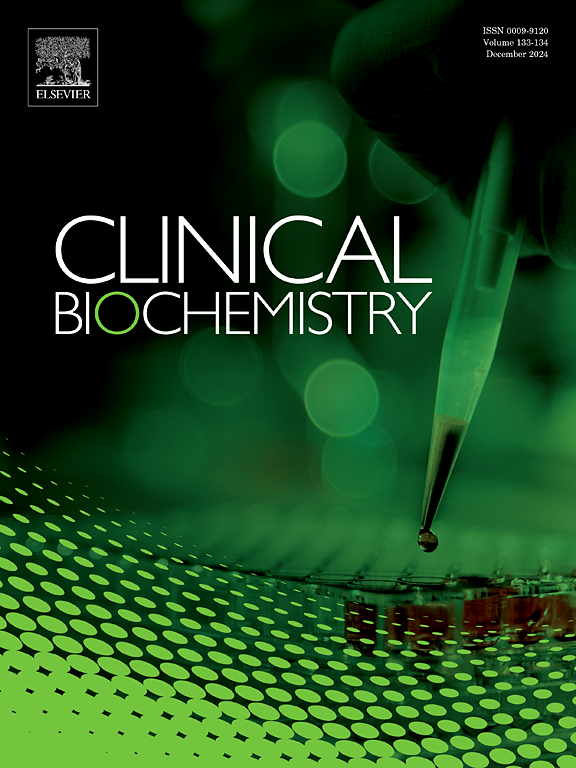泰国的一项队列研究:计算小密度和大浮力低密度脂蛋白-胆固醇及其预测冠状动脉疾病风险的比值
IF 2.1
3区 医学
Q2 MEDICAL LABORATORY TECHNOLOGY
引用次数: 0
摘要
利用Sampson方程推导出的计算出的小密度低密度脂蛋白胆固醇(CsdLDL-C)已被提出作为动脉粥样硬化性心血管疾病风险的筛查工具。目前的研究调查了CsdLDL-C的效用,并计算了大浮力低密度脂蛋白胆固醇(ClbLDL-C)在泰国人群冠状动脉疾病(CAD)风险评估中的作用。方法本研究纳入6448名来自泰国电力管理局(EGAT)前瞻性队列(2007-2009)的无CAD病史的参与者。CsdLDL-C和ClbLDL-C通过标准脂质面板测量来估计。使用Kaplan-Meier生存分析和Cox比例风险模型评估与冠心病风险的关联。结果在平均10.24±1.01年的随访期间,262名(4.06%)参与者经历了CAD事件。在最佳临界值,高CsdLDL-C [>;1.08 mmol/L (41.85 mg/dL)]与冠心病事件显著相关(HR = 1.57; 95% CI = 1.22-2.02),而高ClbLDL-C [>;2.52 mmol/L (97.59 mg/dL)]与冠心病事件呈负相关(HR = 0.72; 95% CI = 0.56-0.92)。CsdLDL-C/ClbLDL-C比值在所有血脂参数中相关性最强(HR = 2.02; 95% CI = 1.58 ~ 2.60)。当单独添加到合并队列风险方程时,CsdLDL-C和CsdLDL-C/ClbLDL-C比值仍然是新发CAD的重要预测因子。他们也表现出良好的区分能力(P < 0.004)。结论由Sampson方程得出的csdldl - c和ClbLDL-C与冠心病风险呈相反方向显著相关。他们的比值具有更大的预测效力。将CsdLDL-C和CsdLDL-C/ClbLDL-C比值纳入心血管风险评估模型,可改善高危人群的早期识别。本文章由计算机程序翻译,如有差异,请以英文原文为准。
Calculated small-dense and large-buoyant low-density lipoprotein-cholesterol and their ratio in predicting coronary artery disease risk: A cohort study in Thailand
Objectives
Calculated, small dense low-density lipoprotein cholesterol (CsdLDL-C), derived using the Sampson equation, has been proposed as a screening tool for atherosclerotic cardiovascular disease risk. The current study investigated the utility of CsdLDL-C and calculated large buoyant low-density lipoprotein cholesterol (ClbLDL-C) for coronary artery disease (CAD) risk assessment in a Thai population.
Methods
This study included 6448 participants without prior CAD from the Electricity Generating Authority of Thailand (EGAT) prospective cohort (2007–2009). CsdLDL-C and ClbLDL-C were estimated from standard lipid panel measurements. Associations with CAD risk were evaluated using Kaplan–Meier survival analysis and Cox proportional hazards models.
Results
Over a mean follow-up period of 10.24 ± 1.01 years, 262 (4.06 %) participants experienced CAD events. At the optimal cutoffs, high CsdLDL-C [>1.08 mmol/L (41.85 mg/dL)] was significantly associated with incident CAD events (HR = 1.57; 95 % CI = 1.22–2.02), whereas high ClbLDL-C [>2.52 mmol/L (97.59 mg/dL)] was inversely associated with incident CAD events (HR = 0.72; 95 % CI = 0.56-0.92). The CsdLDL-C/ClbLDL-C ratio exhibited the strongest association (HR = 2.02; 95 % CI = 1.58–2.60) among all lipid parameters. When individually added to the pooled cohort risk equation, CsdLDL-C and the CsdLDL-C/ClbLDL-C ratio remained significant predictors of new-onset CAD. They also demonstrated good discriminatory power (P < 0.004).
Conclusion
CsdLDL-C and ClbLDL-C, derived using the Sampson equation, were significantly associated with CAD risk in the opposite direction. Their ratio had greater predictive effectiveness. Incorporating CsdLDL-C and the CsdLDL-C/ClbLDL-C ratio into cardiovascular risk assessment models may improve early identification of at-risk individuals.
求助全文
通过发布文献求助,成功后即可免费获取论文全文。
去求助
来源期刊

Clinical biochemistry
医学-医学实验技术
CiteScore
5.10
自引率
0.00%
发文量
151
审稿时长
25 days
期刊介绍:
Clinical Biochemistry publishes articles relating to clinical chemistry, molecular biology and genetics, therapeutic drug monitoring and toxicology, laboratory immunology and laboratory medicine in general, with the focus on analytical and clinical investigation of laboratory tests in humans used for diagnosis, prognosis, treatment and therapy, and monitoring of disease.
 求助内容:
求助内容: 应助结果提醒方式:
应助结果提醒方式:


